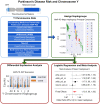Analysis of Y chromosome haplogroups in Parkinson's disease
- PMID: 36387750
- PMCID: PMC9665271
- DOI: 10.1093/braincomms/fcac277
Analysis of Y chromosome haplogroups in Parkinson's disease
Abstract
Parkinson's disease is a complex neurodegenerative disorder that is about 1.5 times more prevalent in males than females. Extensive work has been done to identify the genetic risk factors behind Parkinson's disease on autosomes and more recently on Chromosome X, but work remains to be done on the male-specific Y chromosome. In an effort to explore the role of the Y chromosome in Parkinson's disease, we analysed whole-genome sequencing data from the Accelerating Medicines Partnership-Parkinson's disease initiative (1466 cases and 1664 controls), genotype data from NeuroX (3491 cases and 3232 controls) and genotype data from UKBiobank (182 517 controls, 1892 cases and 3783 proxy cases), all consisting of male European ancestry samples. We classified sample Y chromosomes by haplogroup using three different tools for comparison (Snappy, Yhaplo and Y-LineageTracker) and meta-analysed this data to identify haplogroups associated with Parkinson's disease. This was followed up with a Y-chromosome association study to identify specific variants associated with disease. We also analysed blood-based RNASeq data obtained from the Accelerating Medicines Partnership-Parkinson's disease initiative (1020 samples) and RNASeq data obtained from the North American Brain Expression Consortium (171 samples) to identify Y-chromosome genes differentially expressed in cases, controls, specific haplogroups and specific tissues. RNASeq analyses suggest Y-chromosome gene expression differs between brain and blood tissues but does not differ significantly in cases, controls or specific haplogroups. Overall, we did not find any strong associations between Y-chromosome genetics and Parkinson's disease, suggesting the explanation for the increased prevalence in males may lie elsewhere.
Keywords: Parkinson’s disease; chromosome Y; genetics.
Published by Oxford University Press on behalf of the Guarantors of Brain 2022.
Figures





References
Grants and funding
LinkOut - more resources
Full Text Sources
